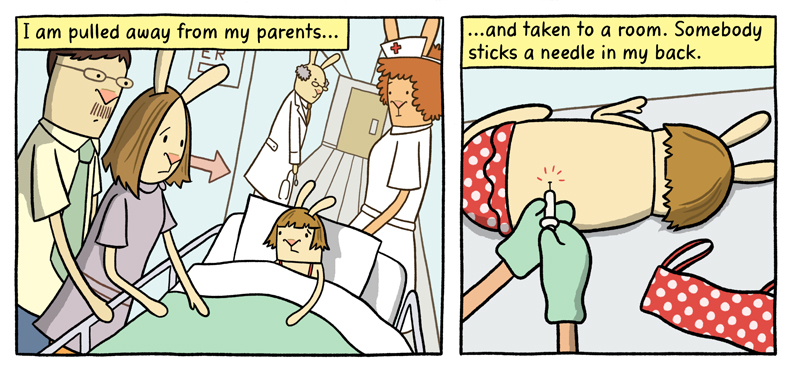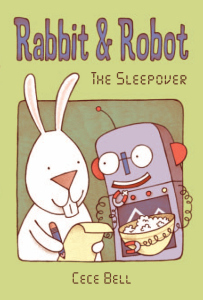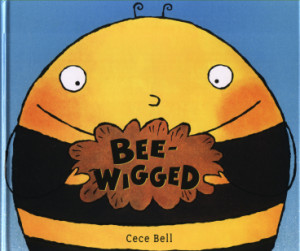 Author-illustrator Cece Bell is coming to the James River Writers conference in Richmond, VA, on October 18-19, and how lucky am I, that I got to interview her ahead of time!
Author-illustrator Cece Bell is coming to the James River Writers conference in Richmond, VA, on October 18-19, and how lucky am I, that I got to interview her ahead of time!
She’s the author of numerous books, including Rabbit & Robot, Bee-Wigged, Itty-Bitty, the Sock Monkey series, and more. She was awesome enough to mail me an advance-reader copy of her new novel-memoir El Deafo, just out this month from Amulet Books. Woot, woot, and welcome, Cece. I’d love to talk with you about the craft of writing…
A.B. Westrick: El Deafo is a great read! The story tugged on my heartstrings from the start, hooking me right in.
Cece Bell: Thank you so much for doing this interview, and for reading the book, and for saying you enjoyed it!
ABW: It’s a great story. And my first question is about El Deafo’s first chapter—a fabulous chapter. You let us glimpse your transition at age four from regular-kid to sick-kid, followed by this line (page 3): “I am pulled away from my parents… and taken to a room. Somebody sticks a needle in my back.” The hook is both figurative and literal—ouch! Then your hospital roommate gets ice cream and you don’t. Oh, the injustice!

I get that you wanted to start the story at the point when your hearing loss started, but you did more than that. You dug deeply into the emotional truth of your situation. My questions are: (1) was that opening always your opening, or did you change it during the writing-and-illustrating process, and (2) what advice do you have for writers who struggle to tap into emotional truths? You’re a master at it! Have you adopted any rituals or memory-tricks to help you resurrect what it felt like to be four… or five… or six years old?
1. That wasn’t always the opening. I was originally going to start the book during the moment that I realize that my very powerful school hearing aid is allowing me to hear my teacher wherever she is in the entire school building. The exact moment, in fact, in which I realize that I have superpowers. But it soon became apparent that none of that would make sense without the back story, the “origin” story. So I decided to start from the beginning. It’s much better this way—it hooks the reader, as you say (the origin stories of comic book superheroes are the best part of comic books, in my opinion)—and it gets the hard stuff out of the way early, so the book can be opened up to more humorous things later.
 2. As to memory, my friends always tell me that I remember things that they don’t remember at all. So I might be blessed with a good memory. I was lucky, too, in that my mom had saved some correspondence with teachers and speech therapists and audiologists (you can see a lot of this at www.cecebell.com); she saved my superpowerful hearing aid, too. Having the correspondence helped me with the chronology, and having the hearing aid triggered lots more memories.
2. As to memory, my friends always tell me that I remember things that they don’t remember at all. So I might be blessed with a good memory. I was lucky, too, in that my mom had saved some correspondence with teachers and speech therapists and audiologists (you can see a lot of this at www.cecebell.com); she saved my superpowerful hearing aid, too. Having the correspondence helped me with the chronology, and having the hearing aid triggered lots more memories.
As to tapping into emotional truths—I’m glad you felt the book did that! In some ways, I still struggle from time to time with similar issues that I dealt with in childhood, so it was easy to tap into what things felt like—I often feel the same way now, it’s just lesser, or calmer.
What’s nice about the graphic novel format is that you can play with the placement and sizing and color of all the elements (i.e. panels and speech balloons and drawings, etc.) to make things as dramatic as you want. So I took the emotions that I know and experience as an adult, and I cranked them up visually so that they matched the totally bonkers emotions I felt as a kid. I know what mad feels like as an adult… and mad when you’re a kid feels MAD. You turn it up!
ABW: One of the joys of reading a graphic novel (or in the case of El Deafo, a graphic memoir) is that some of the story is told in words and some in illustrations. How do you approach your work? Which comes first, the language or the illustrations? When you’re stressed or stuck, do you tend to turn to one art form more than the other?
CB: Initially, the words come first. I try to map it all out in words (this happened, then this, and then this, etc.), as much as I can. Then I rough out each page in comic book form, and new or different words might develop. I keep on tightening up the drawings and the words until I have something good. To read a detailed post I wrote about my process, “El Deafo Extras: from outline to finished product,” click here.
 With my other work (picture books and early readers), I tend to write and write and write until I get the writing as good as I think it can be, and only then do I start drawing. Doing the drawings usually leads to the discovery that the words weren’t really that good, were they? So I begin fine-tuning them—and the pictures—simultaneously. When I’m stressed or stuck, I often go back to the words first…or to the glorious art form that we know and love as television.
With my other work (picture books and early readers), I tend to write and write and write until I get the writing as good as I think it can be, and only then do I start drawing. Doing the drawings usually leads to the discovery that the words weren’t really that good, were they? So I begin fine-tuning them—and the pictures—simultaneously. When I’m stressed or stuck, I often go back to the words first…or to the glorious art form that we know and love as television.
ABW: Ha! That’s great. Okay, new question: the story in El Deafo appears in chronological order, but did you craft it in order? Which scenes/moments came first in your process?
CB: Once I committed to telling the story in order, I pretty much crafted it in order, too. The very first outline I created came in bits and pieces, though, and those bits and pieces were not in order at all.
ABW: You mention in your Acknowledgements that you sent editor Susan Van Metre a 2-page outline, and she “believed in El Deafo… and guided the book through every stage…” Please say more! Would you tell wannabe-graphic-novelists that the way to start is with an outline?
CB: I think every graphic novelist starts his or her graphic novel differently. An outline worked well for me. I also submitted to Susan an entire chapter, in color and very polished, so she could see what I had in mind. The way Susan and I worked together was like this:
- Draw up a chapter, roughly but clearly.
- Send to Susan.
- Susan sends comments back to me.
- Make some of the changes suggested by Susan.
- Send revisions back to Susan.
- Repeat process until Susan and I were both happy!
- Start next chapter.
- When all chapters are done, ink them up!
- Send final inks to Eisner-winning graphic novelist David Lasky to color. (He did an AMAZING job.)
- Color-correct what David sends back to me.
- Send final art to Susan.
- Go back and forth some more, fine-tuning and whatnot.
- Book is DONE!
It was grueling, to say the least!
ABW: Any words of wisdom for aspiring graphic novelists (or memoirists)?
 CB: For the graphic novelists: this is my first time doing one of these, so I probably don’t have the best advice. One thing I can think of is this: Totally get a Wacom pressure-sensitive Cintiq tablet and hook that puppy up to your computer! It saves time AND encourages you to become better at drawing!
CB: For the graphic novelists: this is my first time doing one of these, so I probably don’t have the best advice. One thing I can think of is this: Totally get a Wacom pressure-sensitive Cintiq tablet and hook that puppy up to your computer! It saves time AND encourages you to become better at drawing!
For the memoirists: Try not to worry, like I did, about whose feelings you’re going to hurt, or whether or not your presentation of your life’s story is 100% accurate, or whether or not your chronology is exactly right. It’s far better to attempt a portrayal of how you felt at the time that your story took place. That will get your readers interested. You can always do what I did, and add an afterword saying that you messed with the facts a bit to tell a better story!
 ABW: Great advice. Thank you so much for doing this blog interview with me. Richmond’s writing community is looking forward to meeting you in October!
ABW: Great advice. Thank you so much for doing this blog interview with me. Richmond’s writing community is looking forward to meeting you in October!
CB: I am really looking forward to it, too! Thanks for having me!



Awesome, Anne! Thanks for posting this! I have been slowly slowly getting back into graphic noveling.
And how about a graphic memoir, Pam? You’re so good at digging deeply for emotional truths — you’d hook readers from the get-go with some tough stuff. Hard to write, but also… therapeutic, maybe.
Great interview, Anne! I’m sorry I’m not on the Cybils Graphic Novel panel this year. I’d love to consider Cece’s book. I can still read it, though. And I’d love to see a graphic memoir from Pam.
Thanks, Lyn! While interviewing Cece, there was a point when I wondered what ROGUE might’ve looked like, if you’d done that novel in graphic form. Both your novel and Cece’s have a superpower theme. With your current focus on Legos, I can see those in a graphic novel, too. (But then again, maybe photos–rather than drawings–are best with Legos.) Doing this interview got me thinking a lot about the value of visuals. I love how Cece said that “you can play with the placement and sizing and color…to make things as dramatic as you want.” I’m drafting a YA novel right now–not graphic–and often find myself struggling to make my words (no visuals) capture the drama.